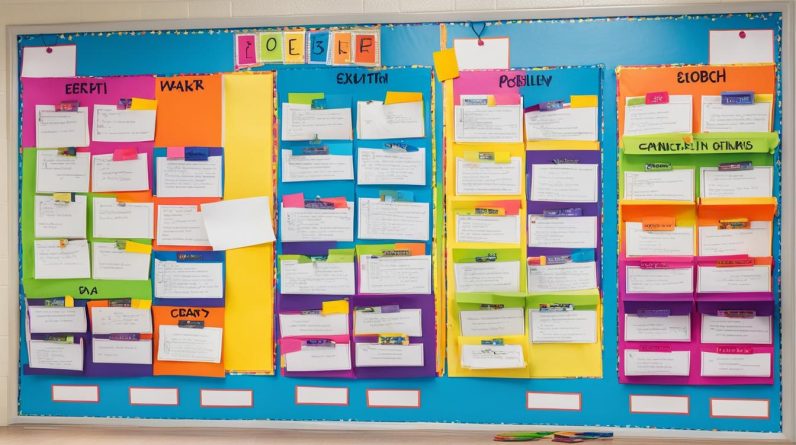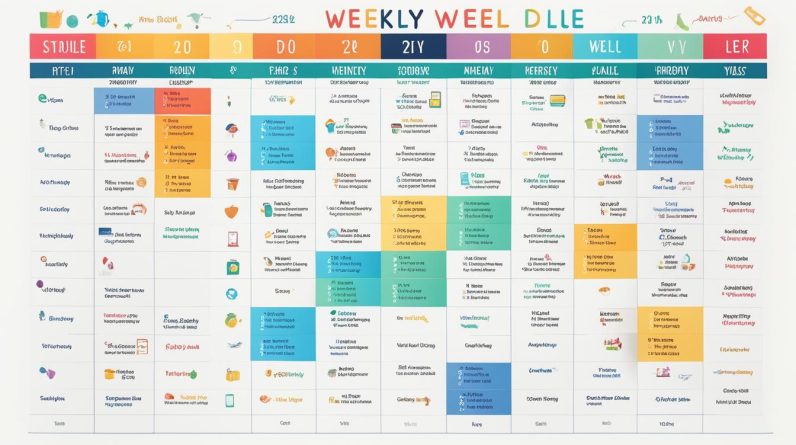When it comes to home schooling, creating engaging and effective lesson plans can be a challenge. However, with the right resources and ideas, you can craft tailor-made lesson plans that will inspire and motivate your children. In this article, we will explore various sources that offer art projects, science experiments, and other educational activities that can be incorporated into your home school curriculum. By utilizing these resources, you can easily design lesson plans that make learning fun for your children.
Key Takeaways:
- Incorporate art projects into your home school curriculum to foster creativity and teach artistic techniques.
- Utilize science experiments to make learning fun and develop critical thinking skills.
- Include themed activities in your lesson plans to add excitement and engage your children.
- Discover valuable tips and secrets for successful homeschool planning.
- Follow a step-by-step guide to start homeschooling and ensure a smooth transition.
Homeschool Art Projects
Looking for engaging art projects to incorporate into your homeschooling curriculum? The first source offers a wide range of art projects specifically designed for homeschooling. These projects cover important art standards and skills, providing a comprehensive art curriculum for your children.
These homeschool art projects can be organized by theme, allowing you to align them with other subjects and create a cohesive learning experience. For example, if you are teaching geography, you can choose landform art projects that complement the lessons. By incorporating these projects into your curriculum, your children will not only learn about art but also develop their creativity and artistic techniques.
Exploring Themes and Skills
From ocean art projects that teach blending and texture techniques to still life projects honing observational skills, there are numerous options to choose from. Each art project comes with tutorials and templates, making it easy to follow along and create beautiful artwork. Plus, the projects can be adapted for different age groups, ensuring that every child can actively participate.
By integrating these homeschool art projects into your curriculum, you can inspire your children’s creativity and provide them with a well-rounded artistic education.
Whether your children are passionate about drawing, painting, or sculpture, these art projects will engage and challenge them, encouraging them to explore their artistic abilities. With step-by-step instructions and templates provided, you don’t need to be an expert in art to guide them through these projects.
To showcase the variety of art projects available, let’s take a look at a few examples:
| Project | Theme | Skills |
|---|---|---|
| Blending in the Ocean | Ocean | Blending techniques, creating textures |
| Landform Sculptures | Geography | 3D modeling, spatial awareness |
| Still Life Drawing | Observation | Line drawing, shading, proportion |
As you can see, these homeschool art projects cover a wide range of themes and skills, ensuring a diverse and enriching artistic experience for your children. By incorporating these projects into your curriculum, you can foster your children’s artistic talents and provide them with a solid foundation in art education.
Science Experiments for Home Schooling
When it comes to homeschooling, incorporating hands-on learning experiences can greatly enhance your child’s understanding and enthusiasm for scientific concepts. The second source in our list offers a diverse collection of science experiments that are perfect for home schooling. These experiments cover a variety of topics and can be adapted to different grade levels, making it easy to tailor your homeschool science curriculum to meet your child’s specific needs and interests.
| Experiment | Description |
|---|---|
| Candy Science Experiments | Explore the principles of color mixing and chemical reactions using simple candies and household materials. This hands-on activity not only teaches your child about scientific processes but also satisfies their sweet tooth! |
| Seed Bombs | Introduce your child to the world of gardening and environmental science with this engaging experiment. By creating seed bombs, they will learn about seed dispersal, plant life cycles, and the importance of biodiversity. |
These science experiments not only engage your child in active learning but also cultivate critical thinking and problem-solving skills. By encouraging your child to observe, hypothesize, and analyze during these experiments, you are fostering their scientific inquiry abilities. Incorporating these hands-on STEM activities into your homeschooling curriculum will not only make science come alive for your child but also instill a lifelong love for learning and discovery.

Themed Activities for Every Month
Looking for exciting and engaging activities to incorporate into your homeschool curriculum? Look no further! The third source offers a wide range of themed activities for every month of the year, designed to make learning fun and interactive. Whether you want to explore the wonders of nature, celebrate holidays, or delve into specific topics, these themed activities will keep your children motivated and inspired throughout the year.
By integrating themed activities into your homeschool planning, you can create a well-rounded curriculum that caters to your children’s interests and fosters a love for learning. Let’s take a closer look at some examples of these exciting activities:
Exploring Nature’s Wonders
Embrace the changing seasons with themed activities that celebrate nature’s beauty. From observing the vibrant colors of fall leaves to planting and tending to a garden in the spring, these activities provide hands-on experiences that connect your children to the world around them.
Celebrating Holidays and Festivals
Add a touch of festivity to your homeschool curriculum by incorporating activities centered around holidays and festivals. Whether it’s creating homemade decorations for Halloween, learning about different cultural traditions during Christmas, or exploring the history of Independence Day, these activities enhance your children’s understanding of diverse celebrations.
Delving into Specific Topics
Take a deep dive into specific subjects with themed activities that focus on particular topics of interest. For example, you could explore different biomes by creating dioramas or conduct experiments to learn about the properties of water. These activities provide a hands-on approach to learning and spark curiosity in your children.
No matter the month or topic, themed activities add variety and excitement to your homeschooling journey. By planning and incorporating these activities into your curriculum, you are creating a dynamic and engaging learning environment for your children.
Remember, when it comes to homeschool planning, flexibility is key. Allow your children’s interests and curiosity to guide the exploration of themed activities. Embrace the opportunity to learn together and create lasting memories.

So, get ready to embark on an unforgettable homeschooling adventure, filled with themed activities that ignite your children’s love for learning. Let the wonders of nature, the joy of holidays, and the depth of specific topics inspire your homeschool curriculum. Your children will thank you for the engaging and immersive educational experience!
Homeschool Planning Secrets & Hacks
Planning and organizing a homeschool curriculum can be overwhelming. But fret not! We have gathered valuable tips and secrets from our fifth source that will make homeschool planning a breeze. Discover the secrets to successful homeschool organization, curriculum planning, and creating a well-structured homeschool schedule.
Homeschool Organization
Homeschool organization is key to a smooth and efficient learning experience. Here are some valuable tips to keep your homeschool organized:
- Create a designated homeschool space: Having a dedicated area for homeschooling can help create a focused and engaging learning environment.
- Utilize storage solutions: Invest in storage bins, shelving units, and organizers to keep your homeschool materials and supplies neatly organized.
- Create a system for tracking progress: Whether it’s a digital planner or a physical binder, having a system in place to track your children’s progress can help ensure that you are covering all the necessary topics and skills.
Curriculum Planning
Curriculum planning plays a crucial role in homeschooling. Here are some effective tips to help you plan a personalized and engaging curriculum:
- Assess your children’s learning styles and interests: Understanding how your children learn best will help you choose curriculum materials and resources that align with their individual needs.
- Utilize online resources: There are many free and affordable online resources available that offer comprehensive curriculum options, lesson plans, and educational activities.
- Think outside the box: Incorporate a variety of teaching methods and resources, such as hands-on activities, educational games, and field trips, to make learning more engaging and enjoyable.
Homeschool Schedule
Creating a well-structured homeschool schedule is essential for maintaining a balance between learning and other daily activities. Here are some tips to help you create an effective homeschool schedule:
- Set a consistent routine: Establish a daily routine that includes dedicated learning time, breaks, meals, and extracurricular activities.
- Utilize a four-day homeschool week: Consider condensing your homeschool week into four days to allow for more flexibility and free time for both you and your children.
- Allow for flexibility: Remember that homeschooling provides the freedom to adapt and adjust your schedule as needed. Embrace flexibility and make changes when necessary to accommodate your children’s individual needs.
By implementing these homeschool planning secrets and hacks, you can create a personalized and well-structured curriculum that meets the educational needs of your children. Homeschooling doesn’t have to be overwhelming—it can be a rewarding and fulfilling journey for both you and your children.
How to Start Homeschooling
If you’re new to homeschooling, getting started can seem daunting. But don’t worry, we’re here to guide you through the process step by step. Follow these tips and recommendations from our sixth source, and you’ll be well on your way to creating a successful homeschooling journey for your children.
Understanding the Legal Requirements
Before you embark on your homeschooling adventure, it’s essential to familiarize yourself with the legal requirements in your state. Each state has its own regulations for homeschooling, so be sure to research and understand the specific laws and procedures you need to follow. This will help you ensure compliance and set a solid foundation for your homeschooling journey.
Choosing a Curriculum
Next, it’s time to choose a curriculum that aligns with your educational goals and your child’s learning style. With a wide range of homeschool curriculum options available, consider factors such as your child’s interests, your teaching style, and the subjects you want to cover. Take advantage of the various online resources and reviews to find a curriculum that suits your needs.
Setting Up a Homeschool Schedule
A well-structured schedule is crucial for a successful homeschooling experience. Establish a daily routine that allows for dedicated learning time, breaks, and other activities. Consider your child’s optimal learning hours and ensure a balance between core subjects, electives, and extracurricular activities. This will help create a predictable and productive learning environment.
“Homeschooling allows for flexibility and customization. Tailor your schedule to fit your family’s unique needs, but remember to incorporate a consistent routine for a sense of stability and progress.” – Sixth Source
Utilizing Homeschooling Resources
Don’t hesitate to explore the wealth of homeschooling resources available to support your journey. Online platforms, libraries, educational websites, and homeschooling communities can provide valuable guidance, lesson plans, educational materials, and inspiration. Tap into these resources to enhance your curriculum, find homeschooling activities, and connect with other homeschooling families.

Creating a Homeschool Schedule
One of the key elements of successful homeschooling is creating a homeschool schedule. By effectively planning and managing your time, you can establish a routine that maximizes learning and keeps your children engaged. Here are some practical tips to help you create a balanced and productive homeschool schedule:
Determine the Best Time of Day for Learning
Every child has a different peak learning time. Some may be more alert and focused in the morning, while others thrive in the afternoon. Observe your children’s energy levels and concentration throughout the day to identify their optimal learning hours. Structure your schedule to prioritize subjects that require more focus during these peak times.
Incorporate Breaks
Just like in a traditional school setting, breaks are important for children to recharge and maintain their attention. Plan short breaks between subjects or activities to allow for physical movement, snacks, or relaxation. These breaks can help prevent burnout and enhance productivity.
Add Extracurricular Activities
Homeschooling presents the opportunity for a flexible schedule, which allows you to include extracurricular activities that align with your children’s interests and passions. Whether it’s art classes, sports activities, or music lessons, incorporating these activities into your homeschool schedule not only provides a well-rounded education but also adds variety and enjoyment to the learning experience.
“Creating a homeschool schedule that works for your family is all about finding the right balance between structure and flexibility. It’s essential to have a routine to provide stability and consistency, while also allowing room for spontaneous learning moments and personal exploration.” – Homeschooling Parent
Remember, your homeschool schedule should be adaptable to meet the changing needs and interests of your children. Be open to adjustments and modifications along the way. With a well-planned homeschool schedule, you can effectively manage your time and create an enriching educational experience for your children.

| Benefits of a Homeschool Schedule | Tips for Effective Time Management |
|---|---|
|
|
Free Homeschool Curriculum Resources
Looking for affordable homeschool curriculum options? Don’t worry, there are plenty of free resources available online that can meet your needs. These resources cover various subjects and grade levels, making it easier for you to find the right educational materials without breaking the bank. Whether you’re homeschooling on a budget or just looking to supplement your existing curriculum, these free resources can be valuable assets. Take advantage of online platforms, educational websites, and teaching tools to enhance your homeschooling experience.
Here are some great free homeschool curriculum resources to explore:
- Online Educational Platforms: Platforms like Khan Academy, Coursera, and edX offer a wide selection of free courses, lessons, and educational material across various subjects and grade levels. These platforms provide interactive learning experiences, making it engaging and enjoyable for your children.
- Open Educational Resources (OER): OER repositories such as OpenStax, CK-12, and OER Commons offer free textbooks, lesson plans, and educational resources that are openly licensed. These resources are designed to be customizable, allowing you to adapt them to your specific homeschooling needs.
- Virtual Libraries: Online libraries like Project Gutenberg and Librivox provide free access to a vast collection of e-books, audiobooks, and classic literature. These resources can supplement your language arts curriculum and help your children develop a love for reading.
- Subject-Specific Websites: Many subject-specific websites offer free educational resources for homeschooling. For example, NASA’s website provides educational materials on space science, while the Smithsonian Learning Lab offers resources on history, art, and culture. Explore websites related to your children’s interests and incorporate their educational content into your curriculum.
- Homeschooling Blogs: There are numerous homeschooling blogs that offer free curriculum resources, activity ideas, and lesson plans. These blogs are often run by experienced homeschooling parents who share their insights and tips. Reading their blogs can provide you with inspiration and valuable information.
By utilizing these free homeschool curriculum resources, you can access high-quality educational materials without spending a fortune. Be sure to explore different options and find the resources that align with your children’s learning style and educational goals.
Testimonials:
“I was amazed by the wealth of free educational resources available online. It has made homeschooling much more affordable for our family!” – Emily S.
“Using free curriculum resources has allowed us to explore a wider range of subjects and activities. It keeps learning fresh and exciting for my children!” – David M.
Planning an Enjoyable Homeschool Year
When it comes to homeschooling, planning the year ahead is crucial for a successful and enjoyable learning experience. By incorporating joy and flexibility into your curriculum, you can create an engaging and dynamic homeschool year that fosters a love for learning in your children.
Instead of rigid schedules and overwhelming lesson plans, consider adopting a more relaxed approach to planning. You don’t need fancy planning software or elaborate systems; a simple spiral notebook can serve as your homeschool planner, allowing you to jot down ideas, track progress, and make adjustments along the way.
One way to infuse joy into your homeschool year is by incorporating a feast of topics. Rather than focusing on a single subject for an extended period, explore a variety of topics throughout the week. This approach keeps things interesting and prevents monotony, allowing your children to experience a wide range of subjects and concepts.
Flexibility is key to joyful learning. Embrace the freedom to deviate from your original plan if your children show interest in a particular topic or want to dive deeper into a subject. Tailor the curriculum to their passions and strengths, allowing them to explore and pursue their interests.
To provide structure and balance, consider implementing a four-day homeschool week. This allows for dedicated learning days and a day for additional activities, field trips, or catching up on missed lessons. The extra day off creates a sense of excitement and anticipation, making the homeschool year more enjoyable for both you and your children.
Key Takeaways:
- Incorporate joy and flexibility into your homeschool curriculum for an enjoyable learning experience.
- Use a simple spiral notebook as your homeschool planner.
- Explore a variety of topics throughout the week to keep learning interesting.
- Be flexible and follow your children’s interests and passions.
- Consider implementing a four-day homeschool week for structure and balance.
Creating an enjoyable homeschool year is all about finding the right balance between structure and flexibility. By planning with joy in mind and adapting to your children’s needs and interests, you can create a homeschool curriculum that nurtures a lifelong love for learning.
Unschooling Ideas for the Homeschool Year
Incorporating unschooling principles into your homeschool curriculum can be a transformative approach to education. Unschooling emphasizes child-led learning, allowing children to explore their interests and passions, ultimately fostering a love for learning. By embracing unschooling, you can empower your children to take ownership of their education and pursue their unique learning journey.
“The essence of unschooling is letting children take charge of their own education, trusting that they will naturally gravitate towards subjects that interest them and learn in their own way.” – Education Expert
As you embark on your unschooling journey, it’s essential to find resources that support this child-led approach. With the following unschooling ideas and collaborative plans, you can create an enriching homeschool curriculum for different grade levels:
1. Interest-Based Projects
Encourage your children to pursue their interests by designing projects centered around their passions. Whether it’s building a model, conducting research, or creating artwork, allow their curiosity to guide their learning.
2. Real-World Experiences
Take learning beyond textbooks and classrooms by engaging in real-world experiences. Visit museums, historical sites, gardens, and local businesses to provide practical, hands-on learning opportunities.
3. Community Connections
Tap into your local community and encourage your children to explore their surroundings. Engage in volunteer work, internships, or apprenticeships to broaden their horizons and foster a sense of civic responsibility.
4. Collaborative Learning
Facilitate group projects and collaborative learning experiences. Encourage your children to work together with their peers, sharing knowledge and skills in a cooperative and supportive environment.
5. Self-Directed Research
Teach your children how to conduct independent research by providing access to books, online resources, and experts in various fields. Guide them in seeking answers to their own questions and cultivating effective research skills.
Remember, unschooling is all about flexibility and trust in your children’s innate curiosity. Tailor your homeschool planning to align with their individual interests, offering guidance and resources along the way.
Unschooling allows your children to flourish as independent learners, nurturing their natural curiosity and ensuring a personalized educational experience. By embracing unschooling principles in your homeschool curriculum, you can create an environment where your children truly thrive.
Homeschool Room Design and Organization
Creating a dedicated homeschool room can enhance your children’s educational experience by providing a focused and productive learning environment. This section offers practical tips and ideas for designing and organizing your homeschool space, ensuring that it is functional, inspiring, and optimized for learning.
Designing a Functional Learning Environment
When designing your homeschool room, consider the following elements to create a space that facilitates effective learning:
- Layout: Arrange furniture and learning stations in a way that promotes flow and ease of movement.
- Lighting: Ensure adequate natural and artificial lighting to reduce eye strain and create a bright and inviting atmosphere.
- Color Scheme: Choose colors that stimulate focus, creativity, and a sense of calm. Consider using a combination of neutrals and accents that complement your teaching style and your child’s preferences.
Image: A visually appealing homeschool room with organized shelves and learning stations.
Organizing Homeschool Supplies and Materials
To ensure smooth and efficient homeschooling sessions, it is essential to have a well-organized system for your homeschool supplies and materials. Consider the following organizational tips:
- Storage Solutions: Utilize shelves, bins, and baskets to categorize and store homeschool supplies such as textbooks, workbooks, art materials, and manipulatives.
- Labeling: Clearly label containers and shelves to make it easy to find and put away supplies, promoting independence and organization skills in your children.
- Daily Routine: Establish a daily routine for tidying up and ensuring that all materials are returned to their designated places at the end of the homeschool day.
Creating an Inspiring Learning Atmosphere
In addition to functionality and organization, infuse your homeschool room with elements that inspire and stimulate creativity and curiosity:
- Displaying Children’s Work: Showcase your children’s artwork, projects, and achievements to celebrate their progress and create a sense of pride and motivation.
- Incorporating Inspirational Quotes: Use wall decals or a bulletin board to display inspirational quotes or positive affirmations that encourage a growth mindset and a love for learning.
- Creating a Reading Nook: Set up a cozy reading corner with comfortable seating, pillows, and a bookshelf filled with a variety of age-appropriate books to foster a love for reading.
By carefully designing and organizing your homeschool room, you can create an environment that supports focused and effective learning. This dedicated space will not only enhance your children’s educational experience but also promote a sense of structure, routine, and enthusiasm for learning.
Homeschooling with a Preschooler
If you have a preschooler and are homeschooling, incorporating engaging activities and effective strategies can make the experience both educational and enjoyable. By tailoring your homeschooling approach to meet the developmental needs of your preschooler, you can lay a strong foundation for their future academic success.
One of the key aspects of homeschooling with a preschooler is incorporating hands-on activities and sensory play. These activities not only promote sensory development but also engage your child’s imagination and creativity. From finger painting and playdough sculpting to sensory bins and nature walks, there are numerous options to choose from.
Furthermore, integrating early childhood education principles into your curriculum can enhance your child’s learning experience. Focus on activities that promote language development, social interaction, and cognitive skills. Incorporate storytelling, rhyming games, counting exercises, and shape recognition activities into your daily routine.
Remember, homeschooling with a preschooler is an opportunity to explore and ignite your child’s curiosity. Embrace their interests and encourage their natural inquisitiveness. By providing a nurturing and stimulating homeschool environment, you can foster a love for learning and set your preschooler on a path towards lifelong education.
FAQ
How can I craft engaging home school lesson plans?
To craft engaging home school lesson plans, you can utilize various resources and ideas available. Incorporate art projects, science experiments, and other educational activities into your curriculum to make learning fun for your children.
Where can I find homeschool art projects?
There are sources that offer a wide range of art projects designed specifically for homeschooling. These projects cover important art standards and skills and can be organized by theme. You can find tutorials, templates, and age-appropriate adaptations for different age groups.
What are some science experiments suitable for home schooling?
You can find a collection of science experiments that are perfect for home schooling. These experiments cover a variety of topics and can be adapted for different grade levels. From candy science experiments to seed bombs, there are numerous hands-on activities to choose from.
Are there themed activities available for every month?
Yes, there are themed activities available for every month. These activities can be based on seasons, holidays, or specific topics. By incorporating themed activities into your curriculum, you can add fun and excitement to the learning process.
What are some homeschool planning secrets and hacks?
There are valuable tips and secrets for effective homeschool planning. You can find advice on utilizing online resources for free homeschool curriculum, creating a daily routine with a four-day homeschool week, and more.
How do I start homeschooling?
If you’re new to homeschooling, you can find a step-by-step guide on how to start homeschooling. This guide covers understanding the legal requirements, choosing a curriculum, setting up a homeschool schedule, and other essential aspects of getting started.
How can I create a homeschool schedule?
You can find insights on how to effectively plan and manage your time as a homeschooling parent. These tips include determining the best time of day for learning, incorporating breaks and extracurricular activities, and creating a balanced and productive homeschool schedule.
Where can I find free homeschool curriculum resources?
There is a list of free homeschool curriculum resources available online. These resources cover a range of subjects and grade levels, offering a cost-effective solution for homeschooling on a budget.
How can I plan an enjoyable homeschool year?
Insights are provided on how to plan an enjoyable homeschool year. These ideas emphasize incorporating joy and flexibility into the curriculum, such as loosely planning with a simple spiral notebook and a four-day homeschool week.
What are some unschooling ideas for the homeschool year?
Unschooling ideas are available for the homeschool year. These ideas focus on child-led learning and provide resources and collaborative plans for different grade levels, inspiring you to embrace unschooling principles in your homeschool curriculum.
How can I design and organize my homeschool room?
You can find tips and ideas for designing and organizing your homeschool room, including creating a functional and inspiring learning environment and effectively organizing homeschool supplies and materials.
Are there specific tips and activities for homeschooling with a preschooler?
Yes, there are tips and activities specifically designed for homeschooling with a preschooler. These tips include incorporating hands-on activities, sensory play, and integrating early childhood education principles into your curriculum.






